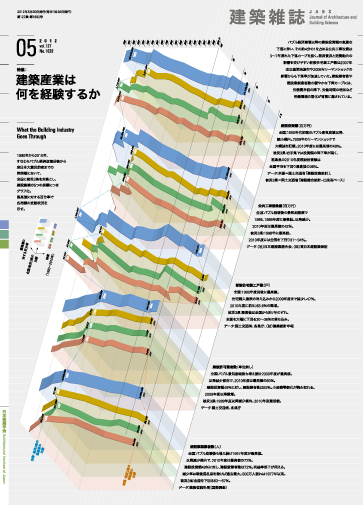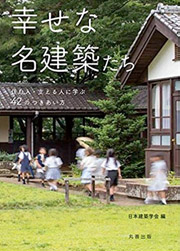本文PDFの閲覧につきましては、こちらでご確認ください。

2012-5月号 MAY
特集= 建築産業は何を経験するか
What the Building Industry Goes Through
特集前言 復興特需の「後」へ何をつなぐか
本誌2002年1月号の特集テーマは「建築業界に未来はあるか」であった。バブル崩壊から10年後である。特に民間投資額の縮小傾向をとらえつつ、業界の「未来」が問われた。それからまた10年が経つ。大都市圏での民間投資の回復傾向こそあれ、公共事業は後退し、特に地方建築業が人員・設備の縮小に追われる一方で、大手ゼネコンはアジア市場に活路を求めてきた。震災前夜における日本の国内建設投資は、1990年代のピークのおおむね5割程度にまで縮小しており、岩手・宮城・福島の3県では3.5 ~ 5割程度になっていた。
建設業界はこうした状況下で「3.11」に襲われた。そのとき組織あるいは個人はどのような対応を迫られたか。国あるいは地域のなかでどのような役割を果たし、どんな課題が浮き彫りになったのか。そして、短期間に巨額が投じられる「復興特需」は、国内市場縮小のなかで生き残りを賭けたこれまでの努力からすれば、極端に逆行した状況を招来する。それを業界はどう経験してゆけばよいのか。本特集ではこうしたテーマを掲げ、諸方面の協力を得て記録と展望をまとめることとした。
では建築産業とは何だろうか。本特集では、(a) 全国あるいは海外までを市場とする大手ゼネコン、(b)地方に依拠し公共事業への依存が相対的に強い地元建設業者、(c) 町場にあって木造住宅等の生産を担う地域工務店、という3つのセクター(部門)を視野の中央に置きながら、他の企業や団体にも産業の一員として目を配ることとした。問題の背景、発災後の対応、復興事業へのかかわり、今後の持続の可能性のいずれもがセクターによって大きく異なる。それらが棲み分け、競合し、また協力し合うかたちで「建築産業」があり、私たちの生活環境を産み出している。東日本大震災はその未来への試金石なのである。
第1部はいわば"俯瞰編"である。林敏彦氏は、近現代の日本が人的被害を減らす一方で厖大な経済被害を生むような社会を築いてきたこと、またストックの破壊・再建が必ずしも次なる経済成長につながらないことを指摘する。遠藤和義氏は、被災地における慌ただしい事態の進捗に即して問題点を指摘しつつ、戦間期ならぬ「震災間期」という時代区分を提起し、戦後の震災間期=経済成長期に形成された地方の産業構造の再編を、復興特需が終わった後の次なる「震災間期」への展望として描き出している。権藤智之氏は統計情報から3.11以前の東北の建築産業についてその特徴を抽出するとともに、統計資料の背景や課題を示す。
第2部は、上掲の各セクターが発災後に何を経験してきたのかを記録する"検証編"である。浅井顕氏と坂川博志氏には、地元建設業者、角倉英明氏には地域工務店が発災直後から取り組んできた活動を克明にレポートしていただいた。また大手ゼネコンについては各社東北支店の方々を中心とする座談会を行い、地域の設計・コンサルタントの経験とその課題についてはJIA東北支部の手島浩之氏に綴っていただいた。いずれも緊迫した現場の状況がひしひしと伝わる報告であり、しかも決して書きやすくない諸問題を美辞で包まず真摯に言葉にしてくださっている。
第3部ではもう少し視野を広げる。浅利美鈴氏は東北の災害廃棄物の特徴をつぶさに指摘しつつ、津波被害の様相ならびに今日の建物と生活様式について再考を促す。また、応急仮設住宅をめぐっては、プレ協会員による5万戸強のほかに、公募による木造仮設住宅の試みが成果を生んだことが建設産業のあり方をめぐって注目されている。三井所隆史氏、安藤邦廣氏に、全体像と具体的な取組みを書いていただいた。一方、いわゆる"みなし仮設"をはじめ、多様な既存ストックによる仮り住まいが全国に分散したのも東日本大震災の特徴であり、島原万丈氏には「仮り住まいの輪」という新しい活動の成果を紹介いただいている。高井賢氏は、被災地常駐の大手ゼネコン社員が、社員そして個人の立場で地域に多様なかかわりを持つに至った状況を伝えている。
第4部は"展望編"であり、松村秀一、赤沼聖吾(日建連支部長)、中城康彦、和田章・布野修司の5氏による座談とした。復興を成し遂げる力が日本にないわけではない。問われるべきは、建設産業各セクターがこの復興をどのように経験すれば、未来へと可能性をつなぐことになるのか、学会の役割とは何か、である。
会誌編集委員会
本号編集担当:竹内泰(宮城大学)・安藤正雄(千葉大学)・東淳子(大林組)・小田島暢之(竹中工務店)・野田郁子
[目次]
| 000 | 連載 再建への意志:図面のなかの都市復興 ネロの黄金宮とローマ市改造計画/桐敷真次郎 |
| 002 | 連載 東日本大震災|連続ルポ1|動き出す被災地 滋賀の森から舞根の海へ/舞根集会所/松岡拓公雄 |
| 004 | 連載 東日本大震災|連続ルポ2|仮すまいの姿 "移動"に伴うコミュニティ形成の課題─仮設住宅自治会の発足経緯を例として 柄谷友香 |
特集 建築産業は何を経験するか
| 006 | 特集前言 復興特需の「後」へ何をつなぐか |
第1部 建築産業の景況
| 008 | 経済発展のパラドックスと専門家の役割/林敏彦 |
| 010 | 建設業の過去、3.11、そして、近未来/遠藤和義 |
| 012 | 被災地の統計情報を集めて感じたこと/権藤智之 |
第2部 建築産業の即応
| 014 | 建設業者、苦闘の1年とこれから/浅井顕 |
| 016 | 献身的な活動をした地元建設業界/坂川博志 |
| 018 | 座談会 記録して未来へ─大手ゼネコンにできること、やるべきこと 小松誠×勝治博 × 曽原実 × 三好純太郎 × 安岡千尋 × 鴨志田隆之 |
| 022 | 東日本大震災が地域工務店の復旧・復興活動に及ぼした作用/角倉英明 |
| 024 | 東北における専門家団体の復興支援活動の一断面─日本建築家協会東北支部宮城復興支援委員会が直面した課題/手島浩之 |
第3部 建築産業の課題
| 026 | 災害廃棄物の視点から「建築」を考える─東日本大震災から1年を経て/浅利美鈴 |
| 028 | 応急仮設住宅・課題検証─東日本大震災における応急仮設住宅建設の背景と今後の供与のあり方について/三井所隆史 |
| 030 | ストックの時代の木造仮設住宅─地域産業の連携で震災復興を図れ/安藤邦廣 |
| 032 | 既存ストックを活用した被災者住宅支援「仮り住まいの輪」─その活動と成果について/島原万丈 |
| 034 | ゼネコン社員として見たもの。個人として見たもの。/高井賢 |
第4部 建築産業の観望
| 035 | 座談会 建築産業の明日へ生かすこと 松村秀一 × 中城康彦 × 赤沼聖吾 × 布野修司 × 和田章 |
| 043 | 編集後記 竹内泰 |
| 043 | 次号予告 2012年6月号|特集:エネルギーホーリック建築 |
| 044 | 特集を読んで 2012年3月号|特集:東日本大震災1周年 リジリエント・ソサエティ 復元力を活かすために/近江弘一 リジリエントなビジョンとは?/佐藤滋 |
| 045 | 連載 建築の争点 「コンパクトシティ」と「間にある都市」/村山顕人 |
| 046 | 連載 なぜ私は建築を選んだか 建築学の懐は深かった/松原斎樹 |
| 047 | 連載 Architect Politician 建築的政治家ジャイメ・レルネル/南條洋雄 |
| 048 | 連載 地域いろいろ・多様な日本 外国人居住者の居場所─ある団地での誕生と終焉/筧政憲 + 小松尚 |
Preface to the Special Issue: What Ties Continue After Special Procurements for Recovery?
The January 2002 issue of this magazine featured the theme "Is there a future in the building industry?" That was ten years after the bubble economy had burst; the industry's future was in question, especially given the tendency toward dwindling amounts of private investment. Now another ten years have passed, and although private investment has tended to recover in metropolitan areas, public projects have generally backed up. Hence, the local building industry particularly has been pushed to reduce personnel and equipment, while by contrast major general contractors have fought to expand into wider Asian markets. Just before the earthquake, national investment in domestic construction had fallen to about 50 percent of the 1990s peak, and had fallen further to 35-50 percent in Iwate, Miyagi, and Fukushima.
Under such conditions, the building industry was besieged by 3.11. At that time, how were organizations or individuals urged to react? What roles did they perform nationally and locally, and what issues emerged? And the special procurements forrecovery, into which vast sums were soon thrown, invited circumstances liable to an extreme reverse contrary to the previousefforts wagered for survival during the contracted domestic market. How would the industry experience it all? We took suchthemes for this feature article and, with cooperation from various fields, gathered records and views.
So, what is the building industry? In this feature, while focusing on three sectors - (a) major general contractors whose market expands nationally and even overseas, (b) local contractors that are based in a region and depend relatively strongly on public projects, and (c) community-based construction companies that cover the production of wooden houses - we tried to watch for other companies and organizations as industry members. The background of problems, post-disaster management, approaches to recovery projects, and the possibility of endurance hereafter - these things all differ completely by sector. The sectors make up the building industry yet have separate domains, compete and cooperate with one another, and produce our living environment. The Great East Japan Earthquake is a touchstone for the future.
Part one is, so to speak, a bird's-eye chapter. Toshihiko Hayashi points out that modern Japan has reduced human harm but has also established a society that brings great economic loss, and that both the destruction and reconstruction of stock do not always lead to economic growth. Kazuyoshi Endo, while addressing issues grounded in the progress at busy disaster areas, also proposes to coin the term inter-earthquake period, modeled on interwar period, and pictures a reorganization of the local industrial structure, which was formed during the postwar inter-earthquake period of economic growth, as a view to the next inter-earthquake period after the recent special procurements for recovery. Tomoyuki Gondo extracts the characteristics of Tohoku's building industry before 3.11 from statistics; at the same time, he presents the background and issues of these statistics.
Part two is a verification chapter that records each of the above sector's experiences since the disaster. Ken Asai and Hiroshi Sakagawa detail the struggles of local contractors, and Hideaki Sumikura the struggles of community-based construction companies. People from the Tohoku branches of major general contractors share a conversation that they led, and Hiroyuki Teshima from the JIA Tohoku Chapter relates his experiences in regional planning and consultation, and the issues involved. All the reports realistically describe tense scenes, and do so earnestly, without ornament, despite that the topics were never easy to talk about.
Part three has a slightly wider scope. Misuzu Asari finely points out the characteristics in Tohoku's disaster debris and prompts a reconsideration of tsunami-disaster phases and today's buildings and lifestyles. And about emergency temporary housing, it is noted, in relation to what the building industry should be, that in addition to the over fifty thousand units produced by the members of the Japan Prefabricated Construction Suppliers & Manufacturers Association, the trial of wooden temporary housing by public bid produced good results. We asked Takashi Miisho and Kunihiro Ando to write about general image and concrete work. Meanwhile, it is characteristic of the Great East Japan Earthquake that temporary housing from various existent stocks, such as the so-called government-subsidized housing that evacuees found by themselves to live in temporarily, spread to all parts of the country; therefore, we asked Manjo Shimahara to introduce the results of a new movement, Karisumai-no-wa. And Ken Takai describes how some staff members of major general contractors who are permanently located in disaster areas approached those areas in various ways as staff and individuals.
Part four is an outlook chapter that presents a conversation with five people: Shuichi Matsumura, Seigo Akanuma (chapter head of the Japan Federation of Construction Contractors), Yasuhiko Nakajo, Akira Wada, and Shuji Funo. We can't say that Japan is powerless to accomplish recovery. But what should be asked, to connect the possibilities to the future, is how each building-industry sector experiences this recovery, and what the role of AIJ is.
Editorial Board
This issue has been edited by Yasushi Takeuchi (Miyagi University), Masao Ando (Chiba University), Junko Azuma (Obayashi Corporation), Nobuyuki Odajima (Takenaka Corporation), and Ikuko Noda
[contents]
| 000 | [Series] The Resolve to Rebuilding: City Reconstruction in Blueprint Golden House of Nero and Remodeling of Rome / Shinjiro Kirishiki |
| 002 | [Series] Great East Japan Earthquake Serial Report 1 Devastated Areas Have Just Started to Stir From Shiga's Forests to the Mone Sea / Mone District Community Center / Takeo Matsuoka |
| 004 | [Series] Great East Japan Earthquake Serial Report 2 Life in Temporary Housing Community-Formation Issues that Come with Relocation ─A Case of Starting Up a Local Organization in Temporary Housing / Yuka Karatani |
Special Feature
What the Building Industry Goes Through
| 006 | [Preface to the Special Issue] What Ties Continue After Special Procurements for Recovery? |
Part1 The Building Industry's Business State
| 008 | The Paradox of Economic Development and the Roles of Experts / Toshihiko Hayashi |
| 010 | The Building Industry: Past, 3.11, and Near Future / Kazuyoshi Endo |
| 012 | Impressions from Statistics of Disaster-Stricken Area / Tomoyuki Gondo |
Part2 The Building Industry's Prompt Response
| 014 | Contractors: A Year of Struggle and Hereafter / Ken Asai |
| 016 | The Action-Dedicated Local Building Industry / Hiroshi Sakagawa |
| 018 | [Discussion] Keep Records and Head for the Future ─What Major General Contractors Could and Should Do Makoto Komatsu × Hiroshi Shoji × Minoru Sohara × Juntaro Miyoshi × Chihiro Yasuoka × Takayuki Kamoshida |
| 022 | The Action to the Restoration Activities of Local Builders by the Great East Japan Earthquake / Hideaki Sumikura |
| 024 | A Phase in the Recovery-Support Activity of a Group of Experts in Tohoku ─The Committee of Reconstruction Assistance of JIA Miyagi, Tohoku Chapter Faced Issues, Strove behind the Scenes / Hiroyuki Teshima |
Part3 The Building Industry's Issues
| 026 | Thinking about Architecture in the Light of Disaster Debris ─One Year After the Great East Japan Earthquake / Misuzu Asari |
| 028 | Verification Issues in Emergency Temporary-Housing ─The Background of Emergency Temporary-Housing for the Great East Japan Earthquake and What Future Supplies Should Be / Takashi Miisho |
| 030 | Wooden Temporary-Housing in the Stock Age ─Make Plans to Recover from Earthquakes by Cooperating with Local Industries / Kunihiro Ando |
| 032 | Karizumai-no-Wa Supports Victims' Housing by Utilizing Existing Stock ─Activity and Results / Manjo Shimahara |
| 034 | View as an Employee of a General Contractor, as an Individual / Ken Takai |
Part4 The Building Industry's Outlook
| 035 | [Discussion] Paving the Way for Tomorrow's Building Industry Shuichi Matsumura × Yasuhiko Nakajo × Seigo Akanuma × Shuji Funo × Akira Wada |
| 043 | [Editor's Postscripts] Yasushi Takeuchi |
| 043 | [Previews of Coming Issues] 2012, Jun|Energy-holic Architecture |
| 044 | [Reviews of Previous Issue] 2012, March|Resilient Society: Commemorating the 3.11 East Japan Earthquake Disaster Doing the Best for Stability / Koichi Ohmi What Is Resilient Vision? / Shigeru Satoh |
| 045 | [Series] Issues in Architecture "Compact City" and "Zwischenstadt" / Akito Murayama |
| 046 | [Series] Why and How I Chose Architecture Architecture Was Broad-Minded / Naoki Matsubara |
| 047 | [Series] Architect Politician Jaime Lerner, an Architectural Politician / Hiroo Nanjo |
| 048 | [Series] Local Identities: Diverse Japan The Place of Foreign Residents ─Birth and Death at a Certain Housing Complex / Masanori Kakehi + Hisashi Komatsu |




 『幸せな名建築たち 住む人・支える人に学ぶ42のつきあい方』
『幸せな名建築たち 住む人・支える人に学ぶ42のつきあい方』





